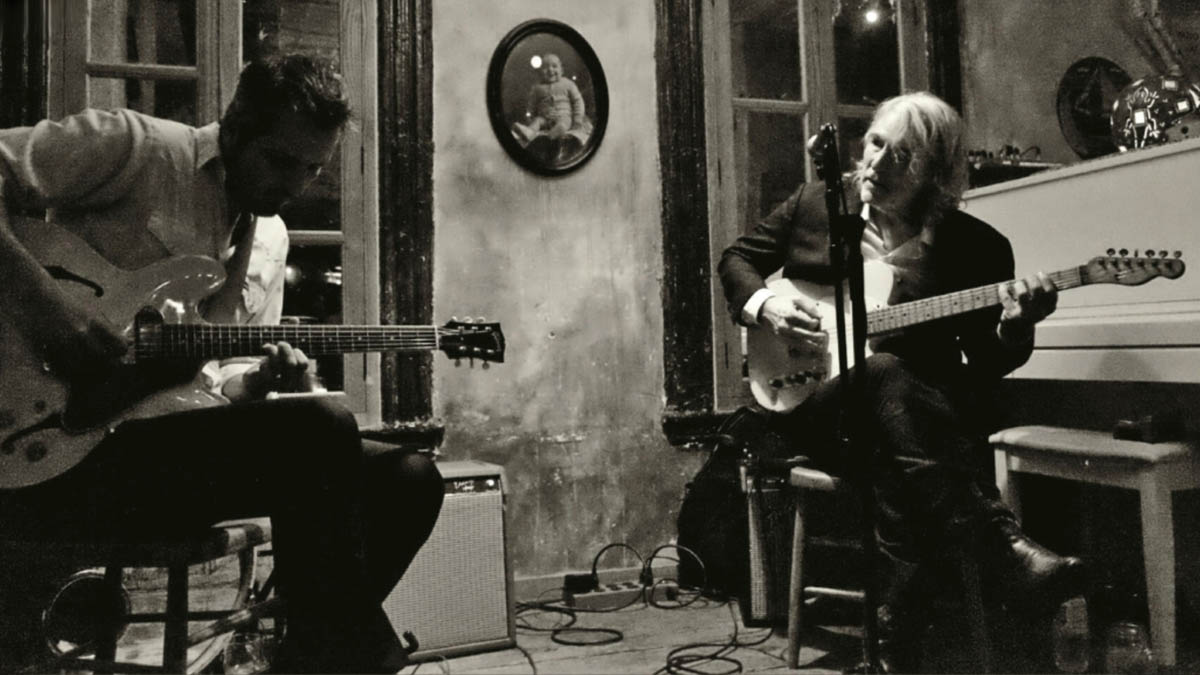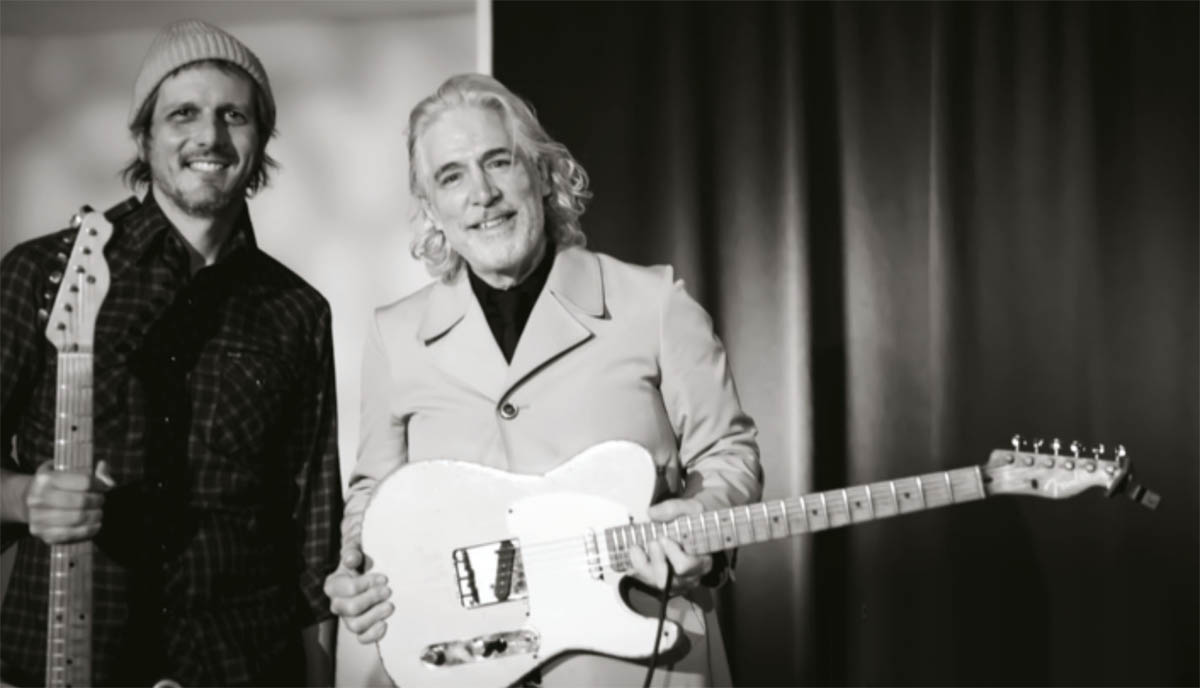Jim Campilongo and Luca Benedetti on Jettisoning the Rhythm Section for a Very Special Six-String Duet
Instigated by necessity, Benedetti and Campilongo establish a dynamic partnership on 'Two Guitars.'

It was a record born from surprise – not the good kind – and struggle. In fact, the whole concept of Two Guitars (Blue Hen Records) wasn’t inspired by the great guitar-duo collaborations of the past, such as Chester & Lester.
It was instigated by necessity. When wicked weather forced their drummer and bassist to go MIA from a gig at New York City’s 55 Bar, guitarists Jim Campilongo and Luca Benedetti decided to press on without a rhythm section.
We relaxed and didn’t worry about filling everything in or keeping a strict tempo going. In those moments, we had a revelation about the creative freedom of a duo
Jim Campilongo
“We said, ‘Let’s just play,’ ” remembers Campilongo, “and we stumbled along, trying to recreate a full band sound with just the two of us. Eventually, we relaxed and didn’t worry about filling everything in – you know, playing ching, ching, ching, ching in a Django Reinhardt style – or keeping a strict tempo going.
“In those moments, we had a revelation about the creative freedom of a duo. We definitely knew we had something going when Luca’s wife told us after the gig, ‘I noticed when you guys would take chances – that’s when it got real good.’ ”
The road to Two Guitars didn’t get all that much easier when the duo decamped to Brooklyn’s The Bunker Studio in mid-2019 to record the album. Campilongo was sick during the sessions, and he didn’t know how sick until later. He had pneumonia.
“We decided to sit down and play, and not have any expectations about the outcome,” Campilongo says. “We didn’t talk about it much, and the tracks ended up sounding pretty wonderful, despite my not feeling my best. Luca and I respect each other, and we have good chemistry, and that certainly helped.”
But even excellent chemistry couldn’t transform one of the album’s final surprises into a welcome one.
“After already playing for seven hours in the studio, Luca drops on me that we should try ‘Mood Indigo’ by Duke Ellington,” Campilongo says. “I was tired, and I didn’t feel like learning anything, so I had a shitty attitude for a few minutes. But Luca is super kind, and he just said, ‘Let’s try it. I bet you could reimagine the horn parts as volume swells.’
“That idea immediately appealed to me, because I’ve found the best-case scenario for me is often discovering a song as the tape is rolling. It’s like falling off a log, and when we can find the magic in the moment like that, then we’re going to be able to compete with really fine music.”
Although Campilongo and Benedetti are enormously accomplished players with massive creative palettes from which they can draw inspiration, they didn’t exactly have an easy time forging the arrangements and musical interplay.
The recording exemplifies Jim and I working that aspect out, and it wasn’t totally painless or effortless. Everyone has their own sense of time, and I had to trust Jim being there for me, and me being there for him
Luca Benedetti
“The minute we started playing as a duo, it took some adjustment,” Benedetti says. “All of a sudden, the strong, driving rhythmic thing that a drummer provides was gone, and we’d notice something would drop out from time to time. Also, neither of us wanted to strum chords constantly for an obvious timing reference, so one of us would take a solo, and we’d go, ‘Um. Ah. Oops.’
“The recording exemplifies Jim and I working that aspect out, and it wasn’t totally painless or effortless. Everyone has their own sense of time, and I had to trust Jim being there for me, and me being there for him.
"In the beginning, we didn’t have our different rhythmic approaches dialed in, so that had to be developed between us. I’d think, This is where I’m feeling it, and I’m just going to keep going, because right now I’m a little confused as to where we are.”
“But we were workhorses,” Campilongo adds. “The more Luca and I played, the more we started reacting, interacting, and honing in on how we could communicate effectively, and what we wanted this duo to sound like.
"One of the things I learned from producer Russ Titelman [Steve Winwood, Eric Clapton, Cyndi Lauper] was that he always wanted everyone to keep playing, keep playing, keep playing. If the musicians are really listening to each other, a special language emerges.”
Another in the ongoing series of surprises during the project was that Campilongo was thwarted from playing the guitar he wanted – a 1958 Gibson ES-225.
One of the bummers about living in New York is the weather is constantly changing. I get a setup, and a week later, the guitar is a mess
Jim Campilongo
“I brought that guitar to all three sessions for the album, and each time something was broken on it,” he says. “It was frustrating, because I’m someone who always gets his guitars and amps worked on before I do anything. Even if I’m just doing a favor for a friend, I make sure my gear is serviced, because the most important thing to have at a session is a guitar that’s perfectly in tune.
“One of the bummers about living in New York is the weather is constantly changing. I get a setup, and a week later, the guitar is a mess. Similarly, no level of preparation mattered with the ES-225. It kept breaking every time I went near the studio. You can see why I’m a little boring with gear and don’t bring five guitars to sessions. In the end, I used my ’59 Fender Telecaster and Princeton amp on Two Guitars.”
Although Benedetti didn’t have to suffer through any equipment tragedies, he still kept his rig pretty sparse. (“Too many factors can mess up a take,” he says.) He mainly used his “parts-caster” based on an old Telecaster and a 1962 Fender Deluxe amp.
For some tracks, he opted for a 1953 Gibson ES-175 with a single P-90 pickup, or a 1966 Epiphone Riviera with mini humbuckers. He also changed things up by plugging into a 1960 Supro Coronado amp when he wanted a more clean and direct sound.
“The Deluxe doesn’t have reverb, but there’s a really nice tremolo on it,” Benedetti says. “I just add a reverb pedal, and I could get away with that setup for the rest of my life. I was excited to play the ES-175 on the record, because I had bought it a week before the session.
“It was so easy to play, and it sounded great. When you hear the melody on ‘Mona Lisa,’ that’s the 175. The best example of the Riviera is my solo on ‘Nice Dress.’ Jim swears it’s the 175 on that tune, but I swear he’s wrong [laughs].”

One of the many delights of Two Guitars is that you can hear the rapport of the two guitarists unfold right before you on every track. It’s an authentic testimony, as well.
You can hear bits of amp hum, fingertips dragging across string winds, and the near-psychic velocity of ideas being tossed back and forth during improvisational sections. It’s a record forged in shared aspirations, experience, respect, and heart.
Luca is always thinking about what the music needs, and he brings it. There’s no autopilot with him
Jim Campilongo
“Jim has this unique ability to always be on task,” Benedetti offers. “I’ll sometimes get distracted by something in the room, and my mind can wander. Not Jim. I feel like he’s always there – 110 percent – and he keeps me focused along with him. I really treasure that. My best playing happens when we play together.”
“We care about each other, and we care about the music,” Campilongo says. “Luca is always thinking about what the music needs, and he brings it. There’s no autopilot with him. As a result, when I listened to a test pressing of Two Guitars, I was so emotionally involved, I was almost holding my breath at times. And I thought, Oh, we did it. We really did it.”
- Jim Campilongo and Luca Benedetti's Two Guitars is out now via Blue Hen Records.
Get The Pick Newsletter
All the latest guitar news, interviews, lessons, reviews, deals and more, direct to your inbox!
“I knew he was going to be somebody then. He had that star quality”: Ritchie Blackmore on his first meeting with Jimmy Page and early recording sessions with Jeff Beck
“He used to send me to my room to practice my vibrato.” His father is the late Irish blues guitar great Gary Moore. But Jack Moore is cutting his own path with a Les Paul in his hands










